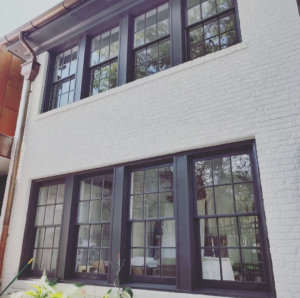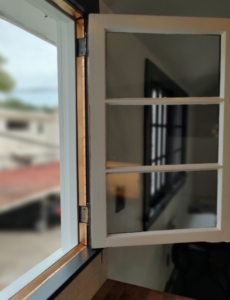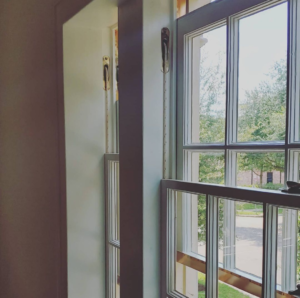Replacement window companies spend large amounts of money a year in advertising costs and have great control on the general public’s attitudes and beliefs surrounding windows. Unfortunately, the story that is being sold on old windows and even their own replacement products is not always accurate. Thankfully, the tide is turning nationally and abroad as trades professionals and historic window owners are beginning to embrace the real story.
Traditional windows have a very specific and very functional design which allows them to last for centuries if given basic attention and care – and even better, allow them to be as energy efficient as modern replacements. The truth is that if you have old windows you have a very valuable invention in your hands that is not replicated in any way by vinyl or composite window manufacturers today.

Why the wooden sash window is a brilliant invention:
Linseed glazing putty, which bridges glass and wood, is calcium carbonate based and meant to be sacrificial at this most vulnerable joint. It fails after a few decades without compromising the wood sash. This glazing joint is beveled and allows direct water run-off. Modern wood windows remove the every-three-decade maintenance factor of linseed glazing by joining wood directly to glass, at the cost of rotting sash in 10-20 years.
Wood sash have vertical joint connections which are un-glued. This directs water away from the sash with minimum impediment. Being able to see hairline joint lines is a sign of health, rather than a water-infiltration point. If the sash does need to expel moisture, it can do so at the non-visible sash perimeter (which slides along the jamb). When the sash is sealed shut with caulking or paint, it loses this evaporation point and the rotting process is accelerated.
Traditional wood windows do not have a rigid track system as part of its functionality. Because structures often shift over time, a track system would cause binding of sash once the window jamb gets out of square. Many traditional windows use a rope and pulley for their functionality, a system which is not proprietary, easily understood, and easy to maintain.
The lines, proportions, and shadow aesthetics of a traditional window are not only beautiful, but give insight into intentional design elements which greatly slow down or block air infiltration, and at every point resolutely directing water away from the building. The way in which the upper sash layers the lower sash, the double air block of the blind stop and parting bead, the way a wooden drip cap slips beneath wood siding above, the way the blind stop reaches far behind the brick curtain wall to safely deposit water to the weep holes, etc. Modern window systems require complicated and doubtful weatherproofing measures and a building culture that is subsequently terrified of water leaks.
Before Heating, Ventilation, and Air Conditioning technologies, a sash window worked with physics by dropping the upper sash five inches and raising the lower sash five inches - effectively circulating warm air out the top and bringing in fresh, cooler air at the bottom.
There's an inherent simplicity and transparency of sash windows that maximizes ease of repair. Wood sash are designed to be deconstructed into perpetuity if necessary - to replace a sash part if needed. This deconstruction doesn't void a warranty and doesn't destroy the sash in the process.
ENERGY EFFICIENCY OF OLD VS. REPLACEMENT:
In 2012, the Federal Trades Commission warned fifteen replacement window manufacturers about their false window claims. A false claim that has been made is that a variety of replacements can provide a 35%-55% energy savings. In reality, windows are only 7%-12% of the entire energy footprint of the home. A study has shown that it takes an average of 41.5 years to recoup the cost of a replacement window with a U value of 0.58 through energy savings. But if the seal breaks on your double insulated glass in 20 years, you will never see the window paid off.

When endeavoring to improve the energy efficiency of your structure, your windows are probably the last place you need to look. Look in these places first:
- Make sure the floor of your attic is well insulated to prevent heat loss in the winter time.
- Sealing air leaks around the perimeter of your windows where the exterior wall cladding
meets the window casing/jamb
- Sealing around baseboards
- Sealing around ventilation points for heating and cooling systems
- Check that fireplace flues and dampers are in good condition and well-sealed in off-seasons, etc.
These common sites of air leakage can have a surprising impact on the energy efficiency of the structure, and usually provide much more improvement than a window that has become “drafty” through neglect. An energy audit can help you to determine the true energy state of your structure and how to get the most savings.
When it comes to improving the energy efficiency of windows, air leakage around the sashes or through deteriorated glazing can be remedied through weatherstripping, glazing repairs, and even storm windows. Glass in any type of window does not do a great job of insulating, so with windows the primary concern should always be air infiltration.
- U-Value of a Replacement Window: 0.58
- U-Value of a properly maintained window with weatherstripping: slightly higher than 0.58 (roughly $5 extra per year than a replacement)
- U-Value of a properly maintained window with weatherstripping and a storm window: 0.50
The evidence shows that a properly maintained traditional window with weatherstripping can come very close to the U-Value of a replacement window and if you add a storm window you can get a lower U-Value than a replacement window, and at a much lower cost. A basic storm window costs around $50 and can be paid back through energy savings within four years. Storm windows can also be a simple fix if you are wanting to improve the energy efficiency of your windows but can’t prioritize window repairs until a later date.

SOURCES:
“Testing the Energy Efficiency of Wood Windows in Cold Climates”, 1996, conducted by the State of Vermont and the U.S. Army Cold Regions Research and Engineering Laboratory.
“An Analysis of the Thermal Performance of Repaired and Replacement Windows”, Authors: Robert Score and Bradford S. Carpenter.
“Thermal Performance of Historic Windows," Author: Chris Wood.
NOTE: These claims are not meant to provide anyone with hard numbers for their window situation, but is merely a guide for making rough estimates. Energy audits and your own research can provide more detailed analyses.
© 2024 Nicholas Bogosian All Rights Reserved
